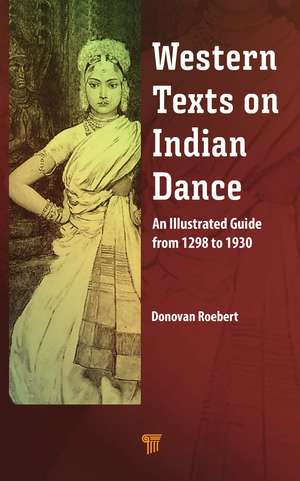Western Texts on Indian Dance: An Illustrated Guide from 1298 to 1930
Autor Donovan Roeberten Limba Engleză Hardback – 21 iul 2022
Preț: 744.60 lei
Preț vechi: 908.04 lei
-18% Nou
Puncte Express: 1117
Preț estimativ în valută:
142.50€ • 148.22$ • 117.64£
142.50€ • 148.22$ • 117.64£
Carte tipărită la comandă
Livrare economică 14-28 aprilie
Preluare comenzi: 021 569.72.76
Specificații
ISBN-13: 9789814968393
ISBN-10: 9814968390
Pagini: 558
Ilustrații: 134
Dimensiuni: 152 x 229 x 30 mm
Greutate: 0.94 kg
Ediția:1
Editura: Jenny Stanford Publishing
Colecția Jenny Stanford Publishing
ISBN-10: 9814968390
Pagini: 558
Ilustrații: 134
Dimensiuni: 152 x 229 x 30 mm
Greutate: 0.94 kg
Ediția:1
Editura: Jenny Stanford Publishing
Colecția Jenny Stanford Publishing
Notă biografică
Donovan Roebert is an artist and writer whose artworks are sold internationally. He has published works on Buddhism, inter-religious dialogue, and Indian dance, as well as a play and four novels. Roebert is an independent researcher into pictorial and textual data for the history of dance in India. He has written articles for various journals and other print media and hosts the blog Aspects of Pictorial Indian Dance History, where he has published more than 50 essays on historical pictorial items relating to Indian dance.
Cuprins
1. Prelude: 1298–1711 2. Sightings, Viewings, Explications, and Opinions: 1770–1830 3. Writings from the Bengal Presidency: 1813–1837 4. The Decade of Encounter: 1830–1840 5. The Beginnings of the Repetitive Narrative: 1840–1850 6. Beautiful Bodies, Graceful Dances, Moral Dilemmas: 1855–1860 7. Getting to Grips with the Bayadère: 1860–1870 8. A Royal Performance and Other Perceptions: 1870–1880 9. A Slowly Brewing Storm: 1880–1890 10. A Detour to the Ethnic Exhibitions and Shows: 1880s–1920s 11. Dancing in India in the Storm of Reform: 1890–1900 12. Loathing, Examination, Analysis, and Appreciation: 1900–1910 13. A Decade of Contradiction and Appropriation: 1910–1920 14. The Beginning of the End: 1920–1930
Descriere
The book reproduces more than 250 extracts from important texts, which provide examples of how dance in India was perceived as an art, as well its position in the broader cultural, religious, social, and ethical environment.
